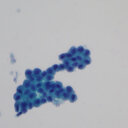Lysine-specific demethylase 1 in breast cancer cells contributes to the production of endogenous formaldehyde in the metastatic bone cancer pain model of rats.
キーワード
概要
BACKGROUND
Bone cancer pain seriously affects the quality of life of cancer patients. Our previous study found that endogenous formaldehyde was produced by cancer cells metastasized into bone marrows and played an important role in bone cancer pain. However, the mechanism of production of this endogenous formaldehyde by metastatic cancer cells was unknown in bone cancer pain rats. Lysine-specific demethylase 1 (LSD1) is one of the major enzymes catalyzing the production of formaldehyde. The expression of LSD1 and the concentration of formaldehyde were up-regulated in many high-risk tumors.
OBJECTIVE
This study aimed to investigate whether LSD1 in metastasized MRMT-1 breast cancer cells in bone marrows participated in the production of endogenous formaldehyde in bone cancer pain rats.
RESULTS
Concentration of the endogenous formaldehyde was measured by high performance liquid chromatography (HPLC). Endogenous formaldehyde dramatically increased in cultured MRMT-1 breast cancer cells in vitro, in bone marrows and sera of bone cancer pain rats, in tumor tissues and sera of MRMT-1 subcutaneous vaccination model rats in vivo. Formaldehyde at a concentration as low as the above measured (3 mM) induced pain behaviors in normal rats. The expression of LSD1 which mainly located in nuclei of cancer cells significantly increased in bone marrows of bone cancer pain rats from 14 d to 21 d after inoculation. Furthermore, inhibition of LSD1 decreased the production of formaldehyde in MRMT-1 cells in vitro. Intraperitoneal injection of LSD1 inhibitor pargyline from 3 d to 14 d after inoculation of MRMT-1 cancer cells reduced bone cancer pain behaviors.
CONCLUSIONS
Our data in the present study, combing our previous report, suggested that in the endogenous formaldehyde-induced pain in bone cancer pain rats, LSD1 in metastasized cancer cells contributed to the production of the endogenous formaldehyde.




